Alignment TOYOTA 4RUNNER 2020 Warranties & Maintenance Guides (in English)
[x] Cancel search | Manufacturer: TOYOTA, Model Year: 2020, Model line: 4RUNNER, Model: TOYOTA 4RUNNER 2020Pages: 260, PDF Size: 8.54 MB
Page 79 of 260

FALKEN
77
Tire Replacement
Falken recommends replacing your tires when the tread wears down
to the wear bars at 1.6mm (2/32 of an inch), which are located across
the tread in several locations around the tire. If only two tires are be\
ing
replaced, the two new tires should always be installed on the rear of
the vehicle to aid in preventing your vehicle from hydroplaning, even
if your car is front wheel drive. It’s always recommended to have your
new tires balanced during installation, and alignment checked if the
previous tires show and irregular wear. Tires that have been in use for
6 (six) years or more should continue to be inspected by a qualified tire
specialist, at least annually. It is recommended that any tires 10 (ten)
years old or older from the date of manufacture, including spare tires, \
be replaced with new tires as a precaution even if such tires appear
serviceable and even if they have not reached the legal worn out limit
at 1.6mm (2/32 of an inch).
Tire Repairs
In the event that you get a flat tire while driving, it is best to find a
nearby, safe place to stop and install your spare tire or call a tow truck.
The less distance that you drive on your low or flat tire, the better
chances your tire has of being repairable. Once you are able to get
to your local servicing tire dealer, have them dismount the tire from
the rim and thoroughly inspect the inside of the tire. It is important t\
o
know the difference between a proper tire repair and an improper one
because it can be critical to you and your vehicle’s safety. An improper
repair could pose a safety threat to you and your family and could
also affect your tire’s manufacturer warranty. Here are some tips in
determining if your damaged tire can be properly repaired or not:•
Always have the tire removed from the wheel and inspected before
any repair is performed.
•
Tires with less than 1.6mm (2/32 of an inch) of tread should NOT
be repaired.
•
Never repair a tire with a puncture larger than 6mm
(1/4 of an inch).
•
Repairs should be limited to the tread area only.
•
Repairs cannot overlap one another.
Page 83 of 260
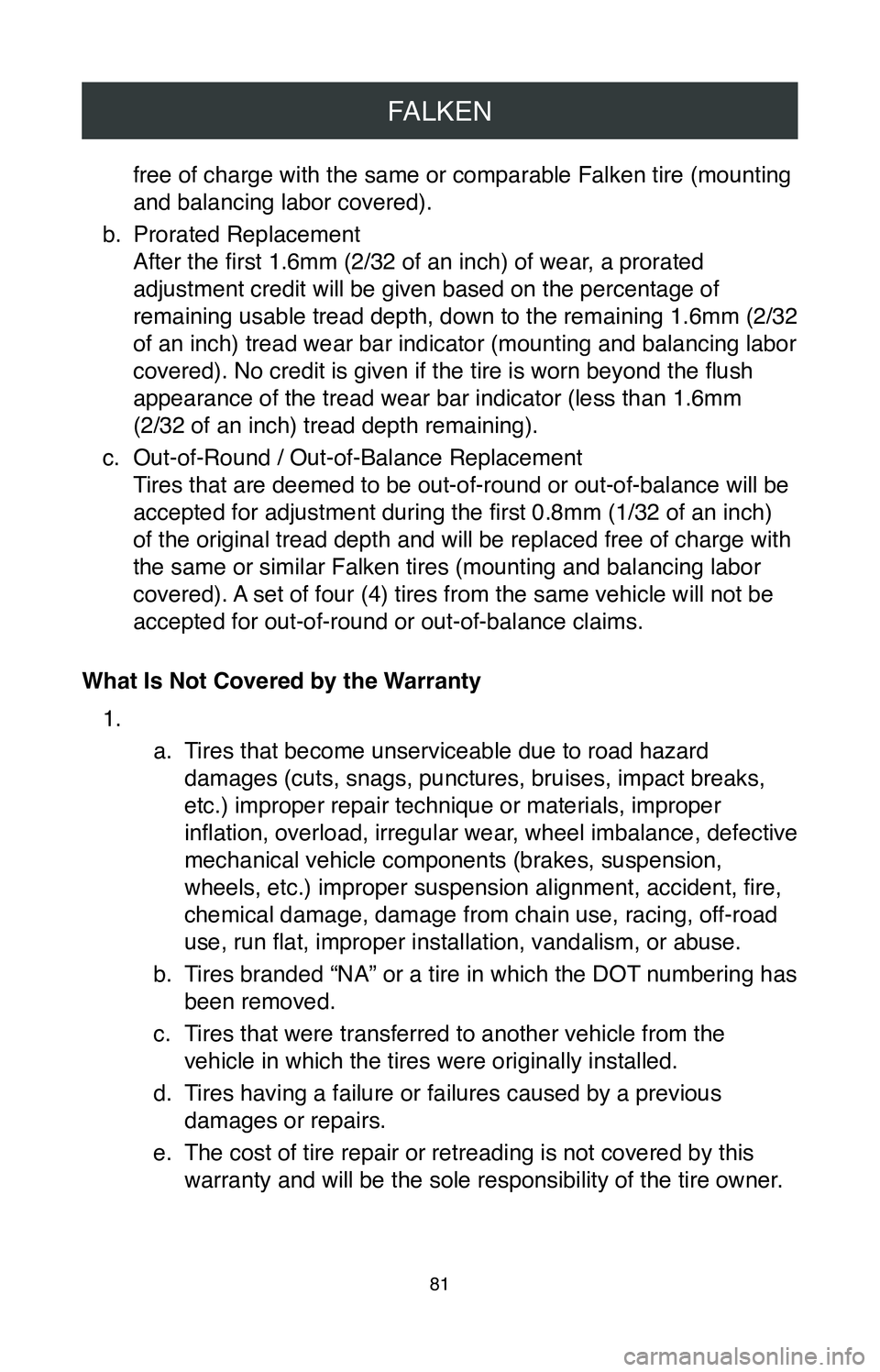
FALKEN
81
free of charge with the same or comparable Falken tire (mounting
and balancing labor covered).
b.
Prorated Replacement
After the first 1.6mm (2/32 of an inch) of wear, a prorated
adjustment credit will be given based on the percentage of
remaining usable tread depth, down to the remaining 1.6mm (2/32
of an inch) tread wear bar indicator (mounting and balancing labor
covered). No credit is given if the tire is worn beyond the flush
appearance of the tread wear bar indicator (less than 1.6mm
(2/32 of an inch) tread depth remaining).
c.
Out-of-Round / Out-of-Balance Replacement
Tires that are deemed to be out-of-round or out-of-balance will be
accepted for adjustment during the first 0.8mm (1/32 of an inch)
of the original tread depth and will be replaced free of charge with
the same or similar Falken tires (mounting and balancing labor
covered). A set of four (4) tires from the same vehicle will not be
accepted for out-of-round or out-of-balance claims.
What Is Not Covered by the Warranty 1.
a. Tires that become unserviceable due to road hazard
damages (cuts, snags, punctures, bruises, impact breaks,
etc.) improper repair technique or materials, improper
inflation, overload, irregular wear, wheel imbalance, defective
mechanical vehicle components (brakes, suspension,
wheels, etc.) improper suspension alignment, accident, fire,
chemical damage, damage from chain use, racing, off-road
use, run flat, improper installation, vandalism, or abuse.
b.
Tires branded “NA” or a tire in which the DOT numbering has
been removed.
c.
Tires that were transferred to another vehicle from the
vehicle in which the tires were originally installed.
d.
Tires having a failure or failures caused by a previous
damages or repairs.
e.
The cost of tire repair or retreading is not covered by this
warranty and will be the sole responsibility of the tire owner.
Page 84 of 260

FALKEN
82
2. Possible NON Covered Reasons/Conditions due to:
Owner’s Obligations
At least monthly, the vehicle owner(s) should check the tires’ air
pressure with a gauge and inflate to the recommended cold air
pressure level listed on the driver’s door placard. Do not rely on car
servicers to perform the checks. The tires should be rotated at least
every 8,000km (5,000 miles) or earlier if uneven wear is occurring, and
proof of maintenance records should be kept. The owner(s) should
have the tires rebalanced if vibration is experienced, and the vehicle’s
alignment should be checked if uneven or rapid wear is occurring, or
when suggested by the vehicle’s manufacturer.
All warranty claims must be presented to an authorized Falken
dealer or participating car dealership. The owner(s) must present any
supporting maintenance records and documentation necessary to help
determine if the tire(s) in question are deemed covered by the limited
warranty or not.
Legal Rights
All implied warranties, including warranties of merchantability and
fitness for a particular purpose shall be limited in duration to the
above period. To the extent permitted by law, Falken Tires shall not
be responsible for incidental or consequential damages, such as loss
of use of the tire or the vehicle on which it is used, inconvenience, or\
Page 100 of 260

HANKOOK TIRE
98
including mounting charge. No adjustment will be made for tires
that are worn more than 50%.
What Is Not Covered by the Warranty
Non Adjustable Conditionsa.
Irregular wear or tire damage due to: Road hazards such as
punctures, cuts, snags, scuffs, carcass bruises or impact breaks.
-Fire, wreck or collision
- Improper inflation, overloading, high speed spinning, improper
mounting or demounting, running flat, off-road use, racing,
vandalism, willful damage or abuse.
-Misalignment, wheel imbalance, defective brakes or shock
absorber, use of tire chains.
- Any tire which has failed as a result of adding materials (e.g. tire
fillers, sealant, or balancing substances).
-Mechanical failure or design of vehicle.
b.
Tires fitted to anything other than the original vehicles.
c.
Tire worn beyond tread wear indicator (2/32nds inch or 1.6mm
tread remaining).
d.
Tire presented by other than the actual owner-user.
e.
Tire branded “NA” (meaning no adjustment) or “blem” (meaning
blemished).
f.
Loss of time inconvenience, loss of use of the vehicle or
consequential damage.
g.
Ride disturbance caused by damaged wheels or after free-
replacement conditions.
h.
Tire with weather cracking which was purchased more than four
years prior to presentation for adjustment.
General Exclusions a.
No Hankook Tire employee, retailer or dealer has the authority
to make any warranty, representation, promise or agreement on
behalf of Hankook Tire except as stated in this policy.
b.
Tires used in racing related activities or competitive events are not
covered by this warranty.
Page 103 of 260
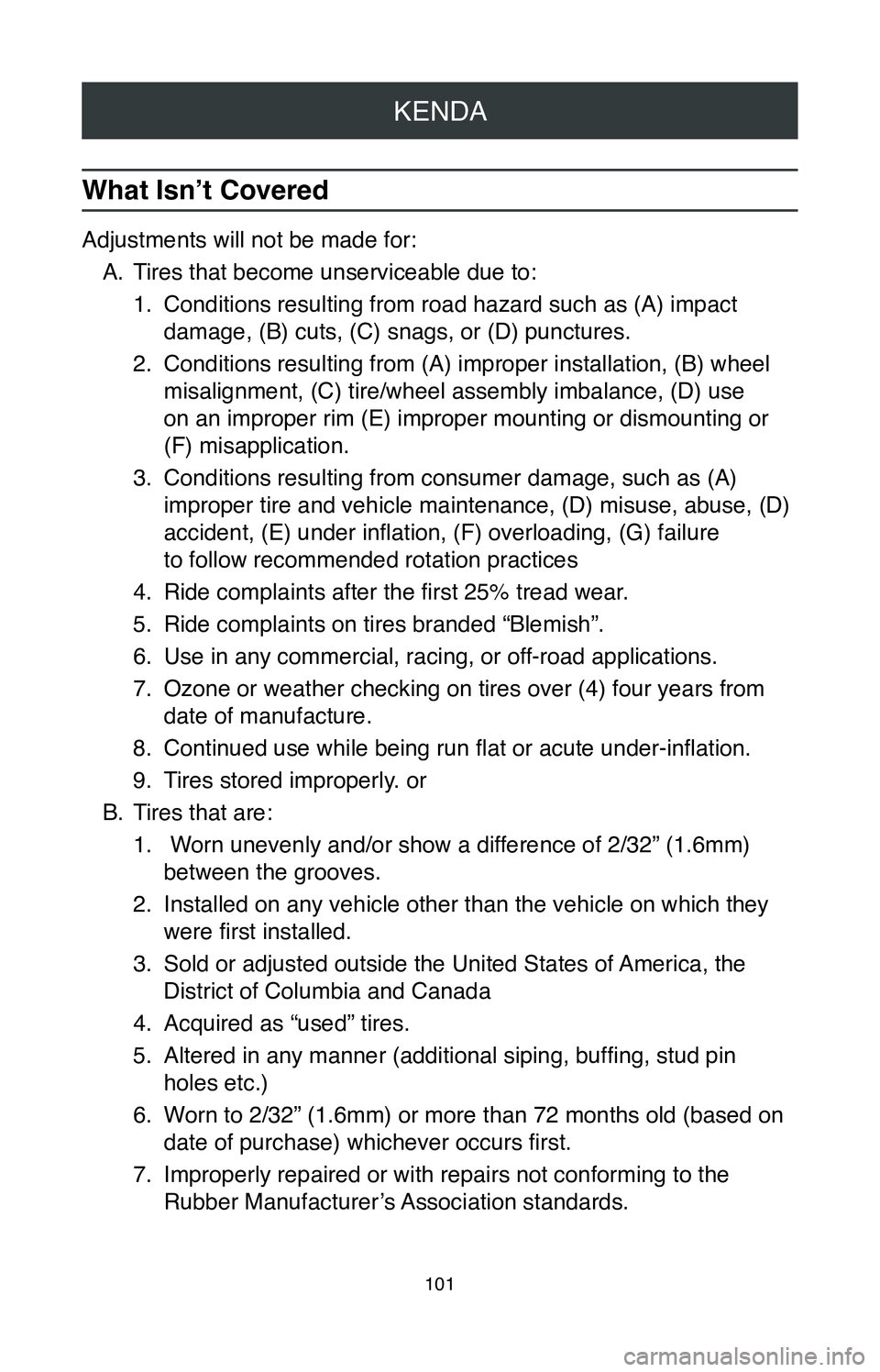
KENDA
101
What Isn’t Covered
Adjustments will not be made for:A.
Tires that become unserviceable due to:
1.
Conditions resulting from road hazard such as (A) impact
damage, (B) cuts, (C) snags, or (D) punctures.
2.
Conditions resulting from (A) improper installation, (B) wheel
misalignment, (C) tire/wheel assembly imbalance, (D) use
on an improper rim (E) improper mounting or dismounting or
(F) misapplication.
3.
Conditions resulting from consumer damage, such as (A)
improper tire and vehicle maintenance, (D) misuse, abuse, (D)
accident, (E) under inflation, (F) overloading, (G) failure
to follow recommended rotation practices
4.
Ride complaints after the first 25% tread wear.
5.
Ride complaints on tires branded “Blemish”.
6.
Use in any commercial, racing, or off-road applications.
7.
Ozone or weather checking on tires over (4) four years from
date of manufacture.
8.
Continued use while being run flat or acute under-inflation.
9.
Tires stored improperly. or
B.
Tires that are:
1.
Worn unevenly and/or show a difference of 2/32” (1.6mm)
between the grooves.
2.
Installed on any vehicle other than the vehicle on which they
were first installed.
3.
Sold or adjusted outside the United States of America, the
District of Columbia and Canada
4.
Acquired as “used” tires.
5.
Altered in any manner (additional siping, buffing, stud pin
holes etc.)
6.
Worn to 2/32” (1.6mm) or more than 72 months old (based on
date of purchase) whichever occurs first.
7.
Improperly repaired or with repairs not conforming to the
Rubber Manufacturer’s Association standards.
Page 105 of 260

KENDA
103
CONSUMER RIGHTS
This Warranty gives you specific legal rights, and you may also have
other rights that vary from state to state.
OWNER’S OBLIGATl0N
When making a claim, you must return the tire to be replaced to your
Kenda Tires dealer.
Proper vehicle and tire care is necessary to obtain the expected wear
from a tire. It is your obligation to properly maintain your tires and
the vehicle upon which they are mounted, including: (A) operating
your tires at the inflation pressures recommended by the vehicle
manufacturer, (B) keeping your tire/wheel assemblies in balance. (C)
proper wheel alignment, and (D) rotation. You must check your tire’s air
pressure at least monthly and before long trips.
We recommend that you have your Kenda Tires dealer inspect your
tires any time you notice irregular or uneven tread wear and rotate
them, if necessary. Also, they should be inspected by your dealer any
time your vehicle is brought in for service.
TREADWEAR LIMITED WARRANTY
For those qualifying brand tires listed in the product chart (see below),
Kenda Tires will provide prorated credit towards the purchase of a
comparable brand tire.
You will be responsible for the prorated cost of a replacement
tire, and also mounting and balancing costs, taxes and any
other charges.
The prorated cost of a replacement tire is determined as follows:
(Actual miles driven) ÷ (Amount of warranted miles) X (Actual current
dealer selling price)
Page 107 of 260
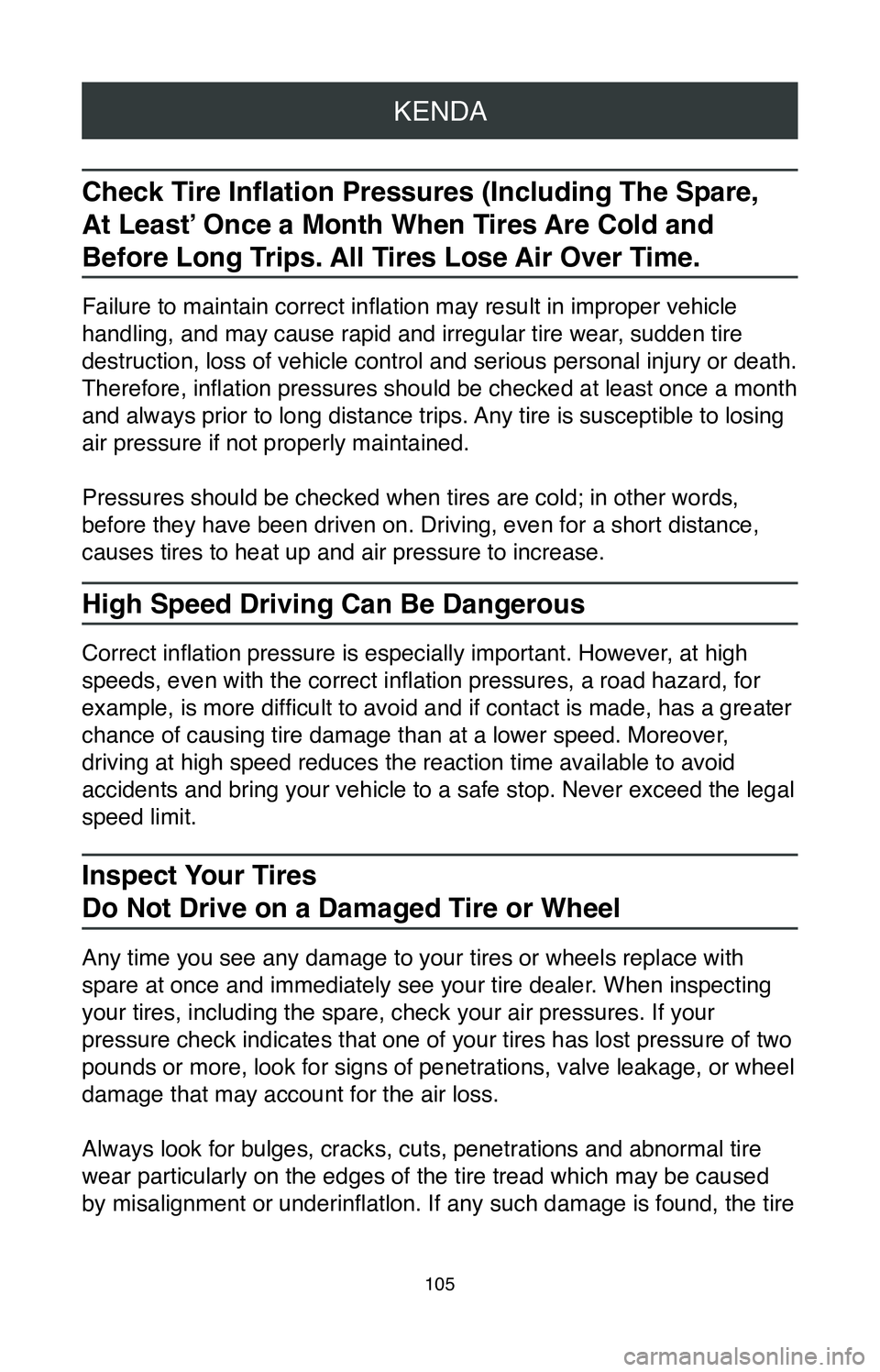
KENDA
105
Check Tire Inflation Pressures (Including The Spare,
At Least’ Once a Month When Tires Are Cold and
Before Long Trips. All Tires Lose Air Over Time.
Failure to maintain correct inflation may result in improper vehicle
handling, and may cause rapid and irregular tire wear, sudden tire
destruction, loss of vehicle control and serious personal injury or death.
Therefore, inflation pressures should be checked at least once a month
and always prior to long distance trips. Any tire is susceptible to losing
air pressure if not properly maintained.
Pressures should be checked when tires are cold; in other words,
before they have been driven on. Driving, even for a short distance,
causes tires to heat up and air pressure to increase.
High Speed Driving Can Be Dangerous
Correct inflation pressure is especially important. However, at high
speeds, even with the correct inflation pressures, a road hazard, for
example, is more difficult to avoid and if contact is made, has a greater
chance of causing tire damage than at a lower speed. Moreover,
driving at high speed reduces the reaction time available to avoid
accidents and bring your vehicle to a safe stop. Never exceed the legal \
speed limit.
Inspect Your Tires
Do Not Drive on a Damaged Tire or Wheel
Any time you see any damage to your tires or wheels replace with
spare at once and immediately see your tire dealer. When inspecting
your tires, including the spare, check your air pressures. If your
pressure check indicates that one of your tires has lost pressure of two\
pounds or more, look for signs of penetrations, valve leakage, or wheel \
damage that may account for the air loss.
Always look for bulges, cracks, cuts, penetrations and abnormal tire
wear particularly on the edges of the tire tread which may be caused
by misalignment or underinflatlon. If any such damage is found, the tire
Page 108 of 260
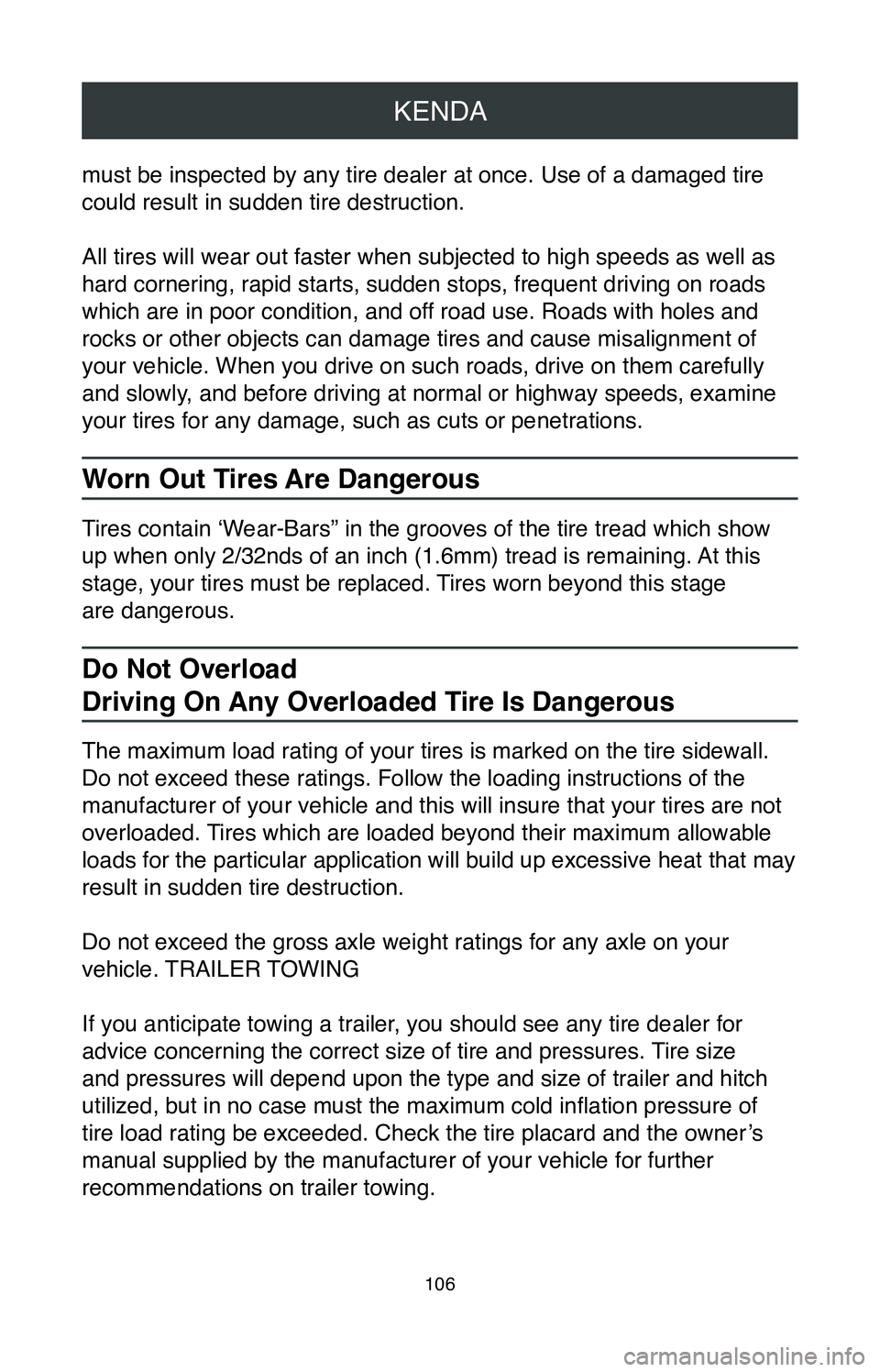
KENDA
106
must be inspected by any tire dealer at once. Use of a damaged tire
could result in sudden tire destruction.
All tires will wear out faster when subjected to high speeds as well as
hard cornering, rapid starts, sudden stops, frequent driving on roads
which are in poor condition, and off road use. Roads with holes and
rocks or other objects can damage tires and cause misalignment of
your vehicle. When you drive on such roads, drive on them carefully
and slowly, and before driving at normal or highway speeds, examine
your tires for any damage, such as cuts or penetrations.
Worn Out Tires Are Dangerous
Tires contain ‘Wear-Bars” in the grooves of the tire tread which show
up when only 2/32nds of an inch (1.6mm) tread is remaining. At this
stage, your tires must be replaced. Tires worn beyond this stage
are dangerous.
Do Not Overload
Driving On Any Overloaded Tire Is Dangerous
The maximum load rating of your tires is marked on the tire sidewall.
Do not exceed these ratings. Follow the loading instructions of the
manufacturer of your vehicle and this will insure that your tires are no\
t
overloaded. Tires which are loaded beyond their maximum allowable
loads for the particular application will build up excessive heat that m\
ay
result in sudden tire destruction.
Do not exceed the gross axle weight ratings for any axle on your
vehicle. TRAILER TOWING
If you anticipate towing a trailer, you should see any tire dealer for
advice concerning the correct size of tire and pressures. Tire size
and pressures will depend upon the type and size of trailer and hitch
utilized, but in no case must the maximum cold inflation pressure of
tire load rating be exceeded. Check the tire placard and the owner’s
manual supplied by the manufacturer of your vehicle for further
recommendations on trailer towing.
Page 109 of 260
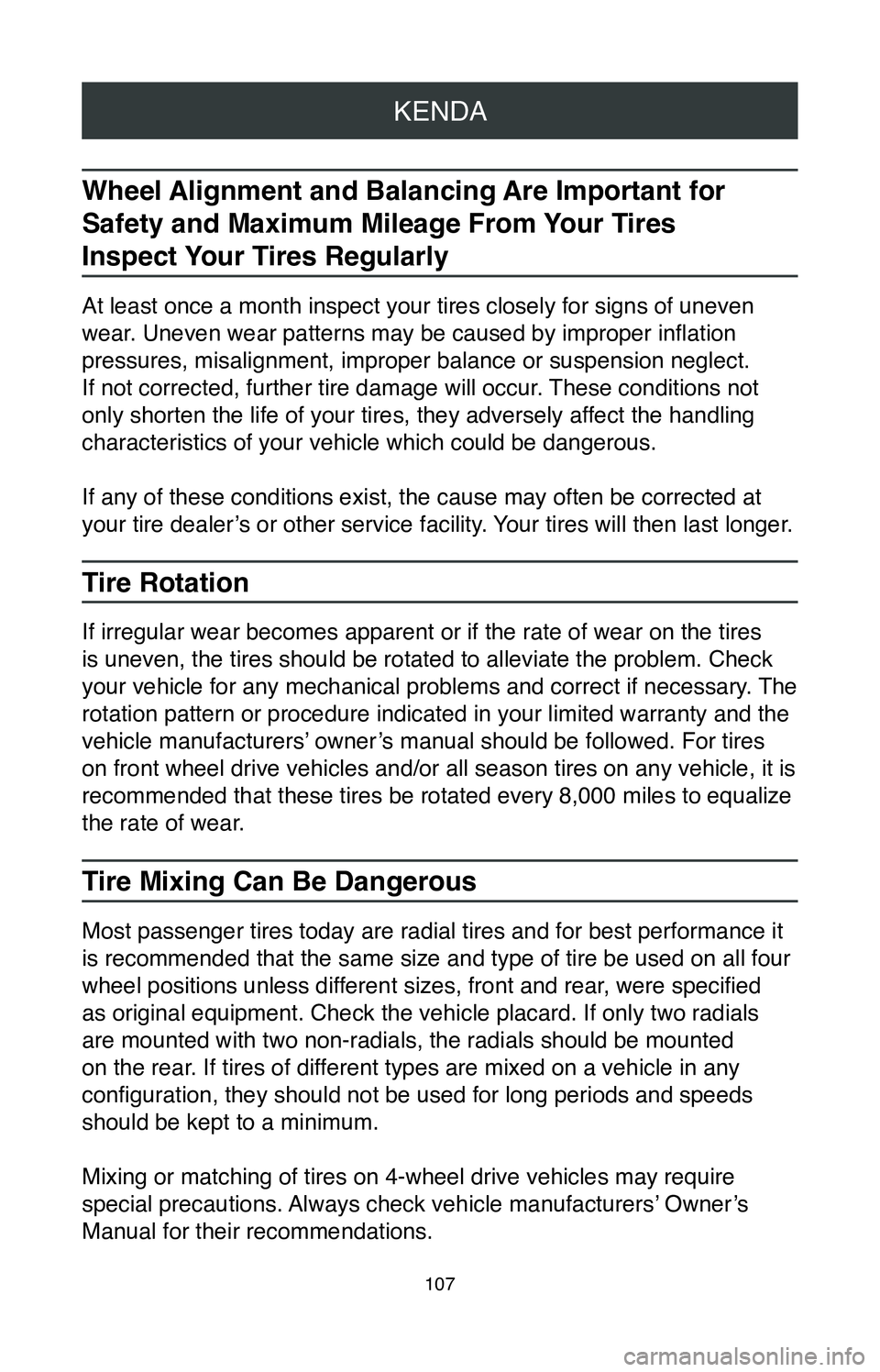
KENDA
107
Wheel Alignment and Balancing Are Important for
Safety and Maximum Mileage From Your Tires
Inspect Your Tires Regularly
At least once a month inspect your tires closely for signs of uneven
wear. Uneven wear patterns may be caused by improper inflation
pressures, misalignment, improper balance or suspension neglect.
If not corrected, further tire damage will occur. These conditions not
only shorten the life of your tires, they adversely affect the handling
characteristics of your vehicle which could be dangerous.
If any of these conditions exist, the cause may often be corrected at
your tire dealer’s or other service facility. Your tires will then last longer.
Tire Rotation
If irregular wear becomes apparent or if the rate of wear on the tires
is uneven, the tires should be rotated to alleviate the problem. Check
your vehicle for any mechanical problems and correct if necessary. The
rotation pattern or procedure indicated in your limited warranty and the\
vehicle manufacturers’ owner’s manual should be followed. For tires
on front wheel drive vehicles and/or all season tires on any vehicle, it\
is
recommended that these tires be rotated every 8,000 miles to equalize
the rate of wear.
Tire Mixing Can Be Dangerous
Most passenger tires today are radial tires and for best performance it \
is recommended that the same size and type of tire be used on all four
wheel positions unless different sizes, front and rear, were specified
as original equipment. Check the vehicle placard. If only two radials
are mounted with two non-radials, the radials should be mounted
on the rear. If tires of different types are mixed on a vehicle in any
configuration, they should not be used for long periods and speeds
should be kept to a minimum.
Mixing or matching of tires on 4-wheel drive vehicles may require
special precautions. Always check vehicle manufacturers’ Owner’s
Manual for their recommendations.
Page 114 of 260
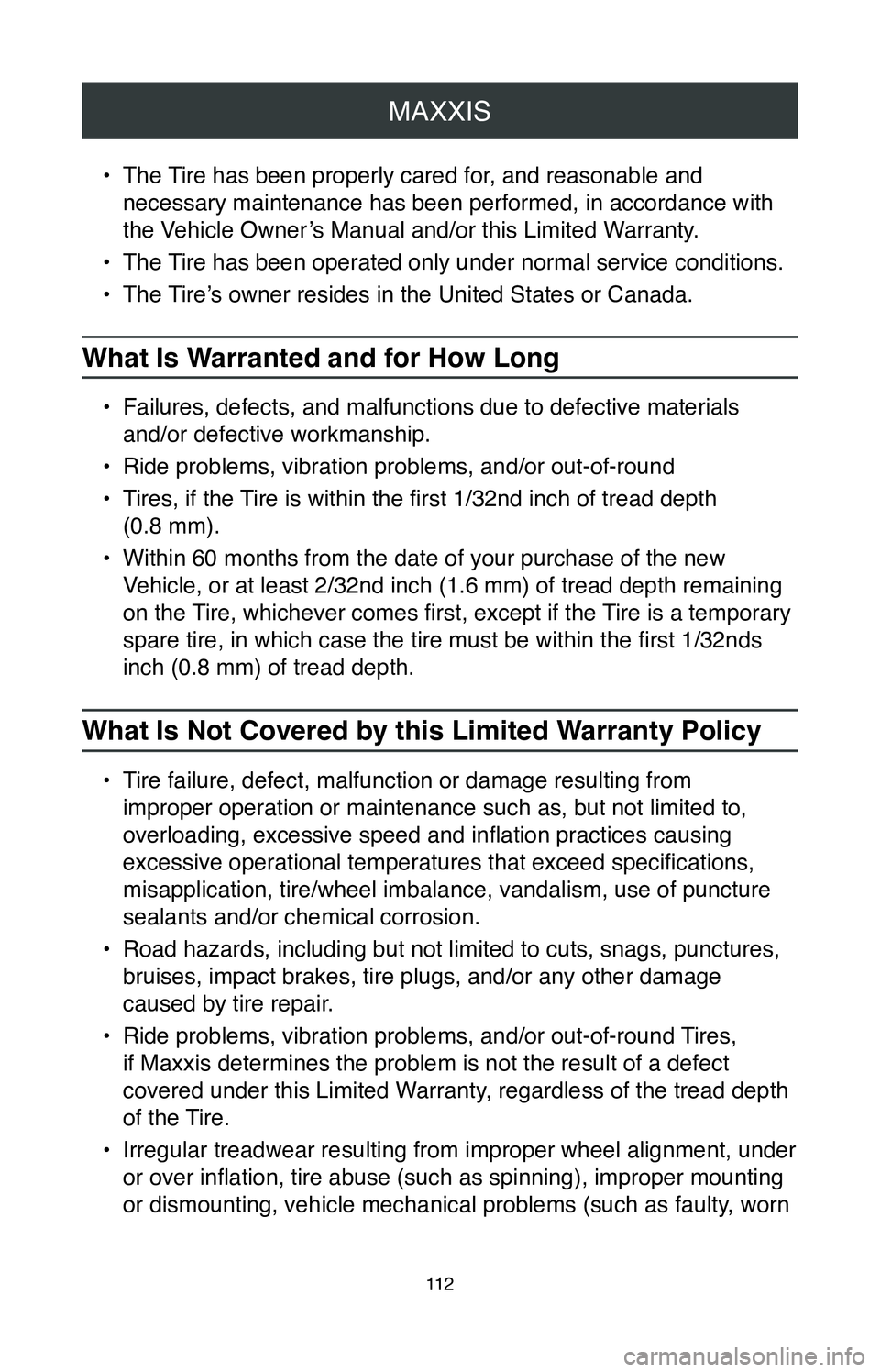
MAXXIS
11 2
• The Tire has been properly cared for, and reasonable and
necessary maintenance has been performed, in accordance with
the Vehicle Owner’s Manual and/or this Limited Warranty.
•
The Tire has been operated only under normal service conditions.
•
The Tire’s owner resides in the United States or Canada.
What Is Warranted and for How Long
• Failures, defects, and malfunctions due to defective materials
and/or defective workmanship.
•
Ride problems, vibration problems, and/or out-of-round
•
Tires, if the Tire is within the first 1/32nd inch of tread depth
(0.8 mm).
•
Within 60 months from the date of your purchase of the new
Vehicle, or at least 2/32nd inch (1.6 mm) of tread depth remaining
on the Tire, whichever comes first, except if the Tire is a temporary
spare tire, in which case the tire must be within the first 1/32nds
inch (0.8 mm) of tread depth.
What Is Not Covered by this Limited Warranty Policy
• Tire failure, defect, malfunction or damage resulting from
improper operation or maintenance such as, but not limited to,
overloading, excessive speed and inflation practices causing
excessive operational temperatures that exceed specifications,
misapplication, tire/wheel imbalance, vandalism, use of puncture
sealants and/or chemical corrosion.
•
Road hazards, including but not limited to cuts, snags, punctures,
bruises, impact brakes, tire plugs, and/or any other damage
caused by tire repair.
•
Ride problems, vibration problems, and/or out-of-round Tires,
if Maxxis determines the problem is not the result of a defect
covered under this Limited Warranty, regardless of the tread depth
of the Tire.
•
Irregular treadwear resulting from improper wheel alignment, under
or over inflation, tire abuse (such as spinning), improper mounting
or dismounting, vehicle mechanical problems (such as faulty, worn